Advanced Constitutive Modeling of the Hot Deformation Behavior of Ni-Based Superalloys: Modified Kobayashi–Dodd and Khan–Huang–Liang Models with Experimental Validation
Abstract
1. Introduction
2. Experimentation
3. Constitutive Modeling
3.1. Kobayashi–Dodd Model (KD)
3.2. Khan–Huang–Liang Model (KHL)
3.3. Modified Kobayashi–Dodd Model (MKD)
3.4. Modified Khan–Huang–Liang Model (MKHL)
4. Results and Discussion
4.1. Comparison of the Predicted and Experimental Stress
4.2. Validation of the Models
5. Conclusions
Author Contributions
Funding
Institutional Review Board Statement
Informed Consent Statement
Data Availability Statement
Acknowledgments
Conflicts of Interest
References
- Shi, Z.; Yan, X.; Duan, C. Characterization of hot deformation behavior of GH925 superalloy using constitutive equation, processing map and microstructure observation. J. Alloys Compd. 2015, 652, 30–38. [Google Scholar] [CrossRef]
- Sujai, S.; Devendranath Ramkumar, K. Microstructure and mechanical characterization of incoloy 925 welds in the as-welded and direct aged conditions. J. Mater. Eng. Perform. 2019, 28, 1563–1580. [Google Scholar] [CrossRef]
- Zhu, Y.; Cao, Y.; Ma, J.; Zhang, J.; He, Q.; Luo, R.; Jia, X.; Liu, Q.; Xiao, J. Cryogenic deformation tailors the dislocation accumulation mode to modify grain boundary character distribution of Incoloy 925. Mater. Charact. 2023, 202, 112995. [Google Scholar] [CrossRef]
- Bao, Z.; Chen, X.; Wu, S.; Xie, L.; Yang, B.; Zheng, K.; Wang, Y. Hot deformation behavior and physical-based constitutive modelling under plane-stress state for nickel-based superalloy sheets. Int. J. Adv. Manuf. Technol. 2024, 134, 1621–1635. [Google Scholar] [CrossRef]
- Wang, H.; Zhang, H.; Liu, C.; Ruan, J.; Huang, H.; Zhou, X.; Meng, F.; Zhu, L.; Zhang, S.; Jiang, L. Hot deformation behavior, superplasticity and microstructure evolution of a new hot isostatic pressed nickel-based superalloy. Mater. Sci. Eng. 2024, 891, 145997. [Google Scholar] [CrossRef]
- Zhong, M.; Yu, H.; Wang, Z.; Zhang, X.; Qu, J. Hot deformation behavior and process parameters optimization of GH4738 nickel-based superalloy. J. Mater. Res. Technol. 2024, 33, 7990–8001. [Google Scholar] [CrossRef]
- Xu, Y.-T.; Wei, J.-L.; Haitao, H.; Nan, H.-Q. Hot deformation behavior and deformation mechanism of γʹ strengthened Co-based superalloys. Mater. Sci. Eng. A 2025, 927, 147932. [Google Scholar]
- Chen, X.-M.; Ning, M.-T.; Hu, H.-W.; Lin, Y.-C.; Zhou, X.-J.; Zhang, J.; Lu, X.-Z.; Chen, J.; Liu, Y.-X. Characterization of hot deformation behavior and optimization of hot workability for GH4698 superalloy. Mater. Charact. 2023, 201, 112916. [Google Scholar] [CrossRef]
- Zhang, Q.; Chang, Y.; Gu, L.; Luo, Y.; Ge, B. Study of microstructure of nickel-based superalloys at high temperatures. Scr. Mater. 2017, 126, 55–57. [Google Scholar] [CrossRef]
- Guo, X.; Zhu, S.; Liu, S.; Cheng, C.; El-Aty, A.A. Unveiling the deformation mechanisms and forming quality of thin-walled tubes manufactured by 3D free bending forming-based MRE medium: A theoretical investigation and FE modeling. Mater. Today Commun. 2025, 44, 111938. [Google Scholar] [CrossRef]
- Sun, B.; Zhang, T.; Song, L. Flow behavior and dynamic recrystallization of a power metallurgy nickel-based superalloy during hot compression in (γ+ γ′)-phase region. J. Alloys Compd. 2022, 891, 161944. [Google Scholar] [CrossRef]
- Ding, Q.; Bei, H.; Yao, X.; Zhao, X.; Wei, X.; Wang, J.; Zhang, Z. Temperature effects on deformation substructures and mechanisms of a Ni-based single crystal superalloy. Appl. Mater. Today 2021, 23, 101061. [Google Scholar] [CrossRef]
- El-Aty, A.A.; Zhang, S.-H.; Xu, Y.; Ha, S. Deformation behavior and anisotropic response of 2060 Al-Cu-Li alloy: Experimental investigation and computational homogenization-based crystal plasticity modeling. J. Mater. Res. Technol. 2019, 81, 1235–1249. [Google Scholar] [CrossRef]
- Jia, L.; Cui, H.; Yang, S.; Lv, S.; Xie, X.; Qu, J. Hot deformation behavior and flow stress modeling of coarse-grain nickel-base GH4151 superalloy ingot materials in cogging. J. Mater. Res. Technol. 2023, 26, 6652–6671. [Google Scholar] [CrossRef]
- Shokry, A.; Gowid, S.; Youssef, S.S. Youssef. Modeling the flow behavior of Haynes 214 superalloy during hot deformation using mathematical and artificial intelligence-based models. Mater. Today Commun. 2022, 33, 104326. [Google Scholar] [CrossRef]
- Hu, Y.; Li, Y.; Fan, W.; Gao, X.; Zhang, Q.; Wang, Q.; Li, W.; Lin, X.; Huang, W. Hot workability and microstructural evolution of a nickel-based superalloy fabricated by laser-based directed energy deposition. J. Alloys Compd. 2022, 920, 165373. [Google Scholar] [CrossRef]
- Li, Y.; Zhang, Y.; Chen, Z.; Ji, Z.; Zhu, H.; Sun, C.; Dong, W.; Li, X.; Sun, Y.; Yao, S. Hot deformation behavior and dynamic recrystallization of GH690 nickel-based superalloy. J. Alloys Compd. 2020, 847, 156507. [Google Scholar] [CrossRef]
- Fesahat, M.; Javidani, M.; Vafaeenezhad, H.; Khademi, D.; Eivani, A.; Mahmoudi, M. Hot deformation behavior and dynamic recrystallization kinetics of Nimonic 901 superalloy. J. Alloys Compd. 2025, 1011, 178234. [Google Scholar] [CrossRef]
- Chang, K.; Ma, C.; Bai, R.; Li, P.; Dong, G.; Tan, Y.; Wang, Y. Gradient hot compression behavior and deformation mechanism of electron beam directionally solidified cast & wrought FGH4096 superalloys with columnar grains. Mater. Sci. Eng. A 2025, 925, 147885. [Google Scholar]
- Zhang, L.; Gour, G.; Petrinic, N.; Pellegrino, A. Rate dependent behaviour and dynamic strain localisation of three novel impact resilient titanium alloys: Experiments and modelling. Mater. Sci. Eng. 2020, 771, 1385. [Google Scholar] [CrossRef]
- Lin, Y.C.; Chen, X.-M. A critical review of experimental results and constitutive descriptions for metals and alloys in hot working. Mater. Des. 2011, 32, 1733–1759. [Google Scholar] [CrossRef]
- Shokry, A.; Gowid, S.; Mulki, H.; Kharmanda, G. On the prediction of the flow behavior of metals and alloys at a wide range of temperatures and strain rates using Johnson–Cook and modified Johnson–Cook-based models: A review. Materials 2023, 16, 1574. [Google Scholar] [CrossRef] [PubMed]
- Zerilli, F.J.; Ronald, W. Armstrong. Dislocation-mechanics-based constitutive relations for material dynamics calculations. J. Appl. Phys. 1987, 61, 1816–1825. [Google Scholar] [CrossRef]
- Yang, P.R.; Cai, M.H.; Wu, C.F.; Su, J.H.; Guo, X.P. Strain-rate dependent hot deformation behavior and mechanism of interphase-precipitated Ti-Mo-xNb steels: Physical modeling and characterization. Mater. Sci. Eng. A 2018, 729, 230–240. [Google Scholar] [CrossRef]
- Buzolin, R.H.; Lasnik, M.; Krumphals, A.; Poletti, M.C. Hot deformation and dynamic α-globularization of a Ti-17 alloy: Consistent physical model. Mater. Des. 2021, 197, 109266. [Google Scholar] [CrossRef]
- Johnson, G.R. A constitutive model and data for metals subjected to large strains, high strain rates and high temperatures. In Proceedings of the 7th International Symposium on Ballistics, The Hague, Netherlands, 19–21 April 1938. [Google Scholar]
- Fields, D.S.; Backofen, W.A. Determination of strain hardening characteristics by torsion testing. Proc. Am. Soc. Test. Mater. 1957, 57, 1259–1272. [Google Scholar]
- Lin, Y.C.; Li, L.-T.; Jiang, Y.-Q. A phenomenological constitutive model for describing thermo-viscoplastic behavior of Al-Zn-Mg-Cu alloy under hot working condition. Exp. Mech. 2012, 52, 993–1002. [Google Scholar] [CrossRef]
- Fatriansyah, J.F.; Suhariadi, I.; Fauziyyah, H.A.; Syukran, I.R.; Hartoyo, F.; Dhaneswara, D.; Lockman, Z.; Fauzi, A.; Rohman, M.S. Prediction and optimization of mechanical properties of Ni-based and Fe–Ni-based superalloys via neural network approach with alloying composition parameter. J. Mater. Res. Technol. 2023, 24, 4168–4176. [Google Scholar] [CrossRef]
- Kumar, S.; Karmakar, A.; Nath, S.K. Construction of hot deformation processing maps for 9Cr-1Mo steel through conventional and ANN approach. Mater. Today Commun. 2021, 26, 101903. [Google Scholar] [CrossRef]
- Hu, D.-C.; Wang, L.; Wang, N.; Chen, M.-H.; Wang, H.-J. Hot tensile deformation behaviors of TA32 titanium alloy based on back-propagation neural networks and three-dimensional thermal processing maps. J. Mater. Res. Technol. 2022, 18, 4786–4795. [Google Scholar] [CrossRef]
- Tao, Z.J.; Fan, X.G.; He, Y.A.N.G.; Jun, M.A.; Heng, L.I. A modified Johnson–Cook model for NC warm bending of large diameter thin-walled Ti–6Al–4V tube in wide ranges of strain rates and temperatures. Trans. Nonferrous Met. Soc. China 2018, 28, 298–308. [Google Scholar] [CrossRef]
- He, J.; Chen, F.; Wang, B.; Zhu, L.B. A modified Johnson-Cook model for 10% Cr steel at elevated temperatures and a wide range of strain rates. Mater. Sci. Eng. A 2018, 715, 1–9. [Google Scholar] [CrossRef]
- Alzahrani, B.; El-Aty, A.A.; Elatriby, S.A.; Sobh, A.S.; Bhlol, M.A.; Elfar, A.A.; Siddiqui, M.A.; Shokry, A. A Modified Johnson Cook Model-Based Kalman Filter Method to Determine the Hot Flow Behavior of Sustainable AA6082 Al Alloy. Materials 2024, 17, 5169. [Google Scholar] [CrossRef]
- Alzahrani, B.; El-Aty, A.A.; Xu, Y.; Hou, Y.; Zhang, S.-H.; Ali, A.; Ahmed, M.M.Z.; Shokry, A. Constitutive Analysis of the Deformation Behavior of Al-Mg-Si Alloy Under Various Forming Conditions Using Several Modeling Approaches. Materials 2025, 18, 1121. [Google Scholar] [CrossRef]
- Li, X.; Guo, G.; Xiao, J.; Song, N.; Li, D. Constitutive modeling and the effects of strain-rate and temperature on the formability of Ti–6Al–4V alloy sheet. Mater. Des. 2014, 55, 325–334. [Google Scholar] [CrossRef]
- Ji, G.; Li, L.; Qin, F.; Zhu, L.; Li, Q. Comparative study of phenomenological constitutive equations for an as-rolled M50NiL steel during hot deformation. J. Alloys Compd. 2017, 695, 2389–2399. [Google Scholar] [CrossRef]
- Huang, X.; Wang, B.; Zang, Y.; Ji, H.; Guan, B.; Li, Y.; Tang, X. Constitutive relationships of 21-4 N heat-resistant steel for the hot forging process. J. Mater. Res. Technol. 2020, 9, 13575–13593. [Google Scholar] [CrossRef]
- Samantaray, D.; Mandal, S.; Borah, U.; Bhaduri, A.K.; Sivaprasad, P.V. A thermo-viscoplastic constitutive model to predict elevated-temperature flow behaviour in a titanium-modified austenitic stainless steel. Mater. Sci. Eng. A 2009, 526, 1–6. [Google Scholar] [CrossRef]
- Sim, K.H.; Kim, L.S.; Han, M.J.; Chu, K.H.; Li, Y.J.; Li, J.H. Development and improvement of phenomenological constitutive models for thermo-mechanical processing of 300M ultra-high strength steel. J. Mater. Eng. Perform. 2024, 33, 1021–1033. [Google Scholar] [CrossRef]
- Cheng, C.; Guo, J.; El-Aty, A.A.; Cao, L.; Xu, L.; Huang, L. Approach based on response-surface method to optimize lining of dies used in 3D free-bending forming technology. Chin. J. Mech. Eng. 2024, 37, 110. [Google Scholar] [CrossRef]
- Li, F.; Zhu, C.; Li, S.; Jiang, H.; Zhang, P.; Yang, R.; Zhao, S. A comparative study on modified and optimized Zerilli-Armstrong and arrhenius-type constitutive models to predict the hot deformation behavior in 30Si2MnCrMoVE steel. J. Mater. Res. Technol. 2022, 20, 3918–3929. [Google Scholar] [CrossRef]
- Abd El-Aty, A.; Shokry, A. Assessment and Comparison of Phenomenological and Physical Constitutive Models for Predicting the Hot Deformation Behavior of Metallic Materials: A Pathway for Sustainable Metal Forming in Al-Kharj Governorate. Materials 2025, 18, 2061. [Google Scholar] [CrossRef]
- Shokry, A. Modified Fields-Backofen and Zerilli-Armstrong constitutive models to predict the hot deformation behavior in titanium-based alloys. Sci. Rep. 2024, 14, 8359. [Google Scholar] [CrossRef]
- Kobayashi, H.; Dodd, B. A numerical analysis for the formation of adiabatic shear bands including void nucleation and growth. Int. J. Impact Eng. 1989, 8, 1–13. [Google Scholar] [CrossRef]
- Khan, A.S.; Liang, R. Behaviors of three BCC metal over a wide range of strain rates and temperatures: Experiments and modeling. Int. J. Plast. 1999, 15, 1089–1109. [Google Scholar] [CrossRef]
- Trimble, D.; O’donnell, G.E. Constitutive modelling for elevated temperature flow behaviour of AA7075. Mater. Des. 2015, 76, 150–168. [Google Scholar] [CrossRef]
- Tang, B.; Li, H.; Guo, N.; Zhang, H.; Liu, G.; Li, X.; Zuo, Y. Revealing ductile/quasi-cleavage fracture and DRX-affected grain size evolution of AA7075 alloy during hot stamping process. Int. J. Mech. Sci. 2021, 212, 106843. [Google Scholar] [CrossRef]
- Chen, G.; Ren, C.; Qin, X.; Li, J. Temperature dependent work hardening in Ti–6Al–4V alloy over large temperature and strain rate ranges: Experiments and constitutive modeling. Mater. Des. 2015, 83, 598–610. [Google Scholar] [CrossRef]
- Singh, G.; Chakraborty, P.; Tiwari, V. A comparative study of different constitutive models to predict the dynamic flow behaviour of a homogenised AT61 magnesium alloy. Structures 2023, 54, 631–643. [Google Scholar] [CrossRef]
- Chakraborty, P.; Singha, M.K.; Tiwari, V. Anisotropic mechanical response of AA7475-T7351 alloy at different loading rates and temperatures. Thin Walled Struct. 2023, 188, 110842. [Google Scholar] [CrossRef]
- Zhao, S.; Petrov, Y.V.; Zhang, Y.; Volkov, G.; Xu, Z.; Huang, F. Modeling of the thermal softening of metals under impact loads and their temperature–time correspondence. Int. J. Eng. Sci. 2024, 194, 1039. [Google Scholar] [CrossRef]
- Chen, G.; Lu, L.; Ren, C.; Ge, X. Temperature dependent negative to positive strain rate sensitivity and compression behavior for 2024-T351 aluminum alloy. J. Alloys Compd. 2018, 765, 569–585. [Google Scholar] [CrossRef]
- Zhu, Y.; Cao, Y.; Liu, C.; Luo, R.; Li, N.; Shu, G.; Huang, G.; Liu, Q. Dynamic behavior and modified artificial neural network model for predicting flow stress during hot deformation of Alloy 925. Mater. Today Commun. 2020, 25, 101329. [Google Scholar] [CrossRef]
- Zhang, J.; Wu, C.; Peng, Y.; Xia, X.; Li, J.; Ding, J.; Liu, C.; Chen, X.; Dong, J.; Liu, Y. Hot compression deformation behavior and processing maps of ATI 718Plus superalloy. J. Alloys Compd. 2020, 835, 155195. [Google Scholar] [CrossRef]
- Wang, M.J.; Sun, C.Y.; Fu, M.W.; Liu, Z.L.; Qian, L.Y. Study on the dynamic recrystallization mechanisms of Inconel 740 superalloy during hot deformation. J. Alloys Compd. 2020, 820, 153325. [Google Scholar] [CrossRef]
- Zhang, J.Y.; Xu, B.; Tariq, N.H.; Sun, M.; Li, D.; Li, Y.Y. Microstructure evolutions and interfacial bonding behavior of Ni-based superalloys during solid state plastic deformation bonding. J. Mater. Sci. Technol. 2020, 46, 1–11. [Google Scholar] [CrossRef]
- Tan, L.; Li, Y.; He, G.; Liu, F.; Nie, Y.; Jiang, L. Optimized hot workability of a powder metallurgy nickel-base superalloy. Mater. Charact. 2019, 147, 340–352. [Google Scholar] [CrossRef]
- Hagan, M.T.; Menhaj, M.B. Training feedforward networks with the Marquardt algorithm. IEEE Trans. Neural Netw. 1994, 5, 989–993. [Google Scholar] [CrossRef]
- Shokry, A.; Gowid, S.; Kharmanda, G. An improved generic Johnson-Cook model for the flow prediction of different categories of alloys at elevated temperatures and dynamic loading conditions. Mater. Today Commun. 2021, 27, 102296. [Google Scholar] [CrossRef]
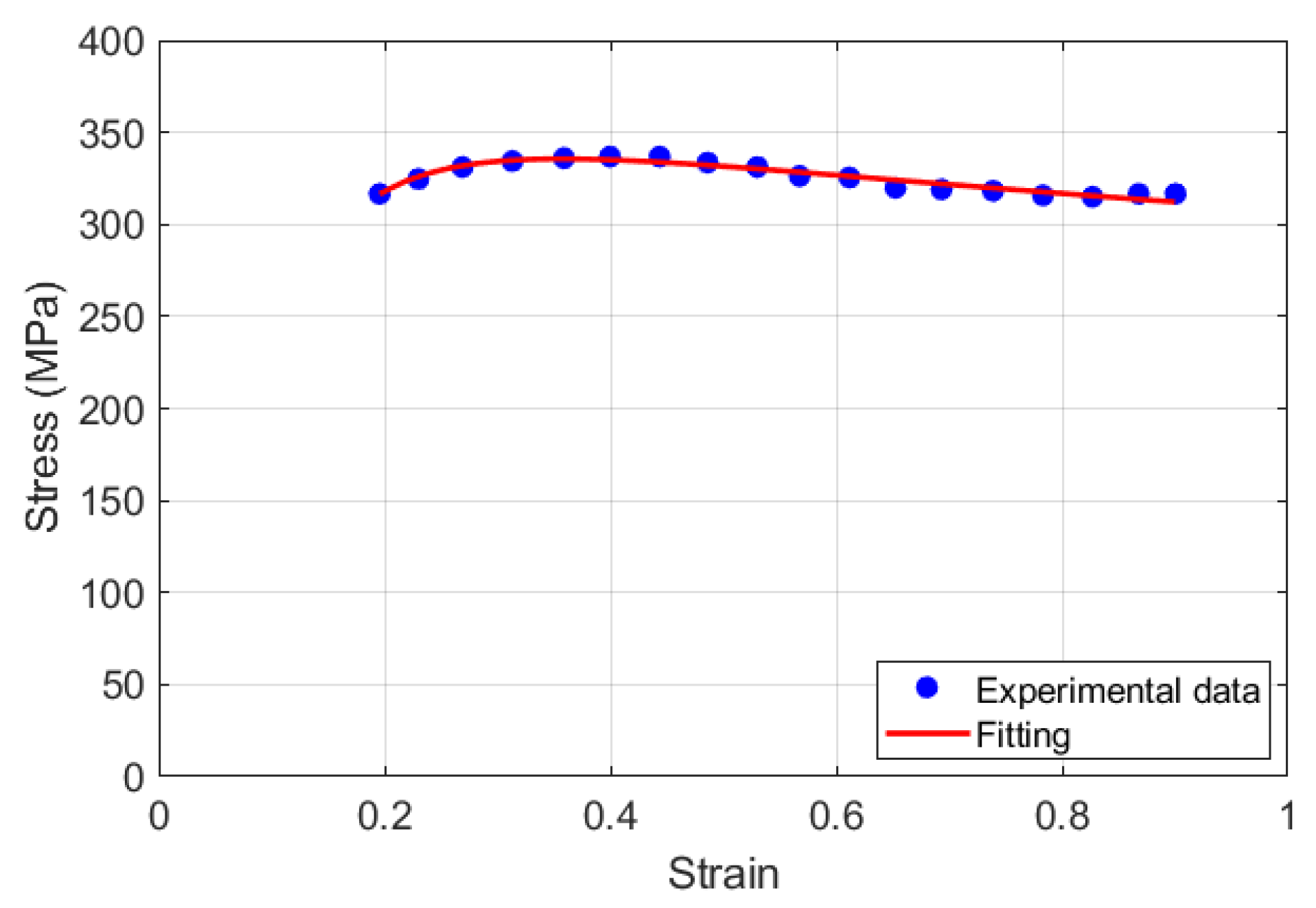
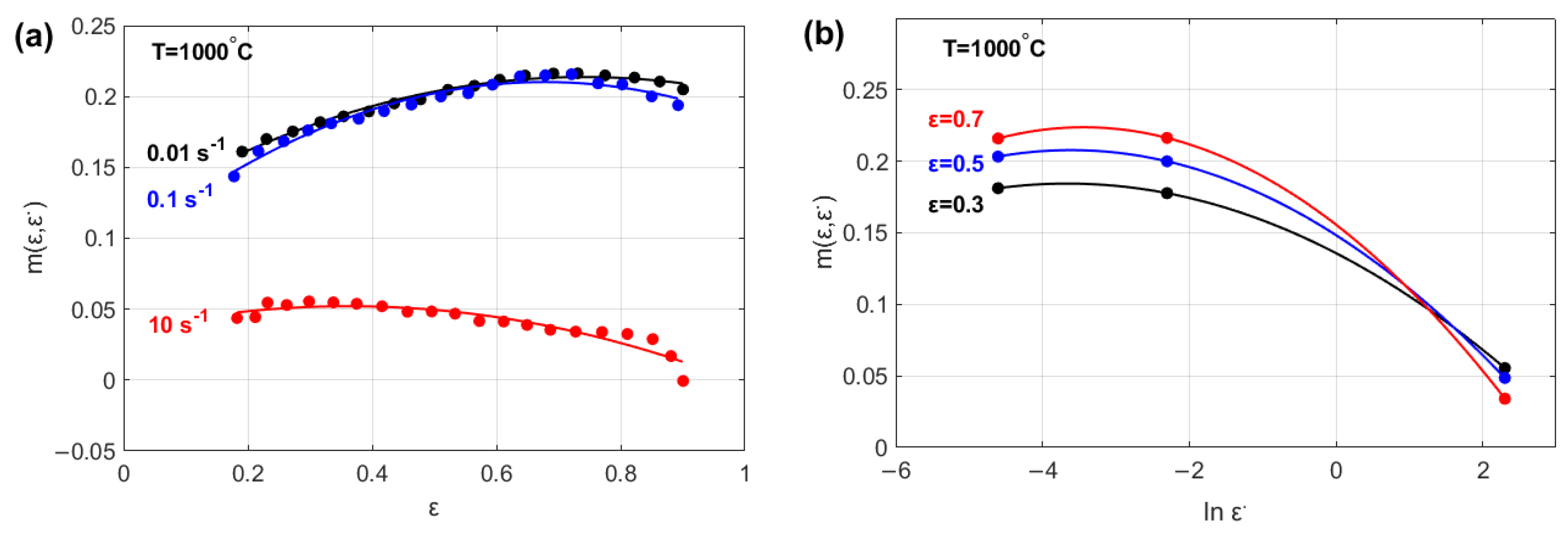
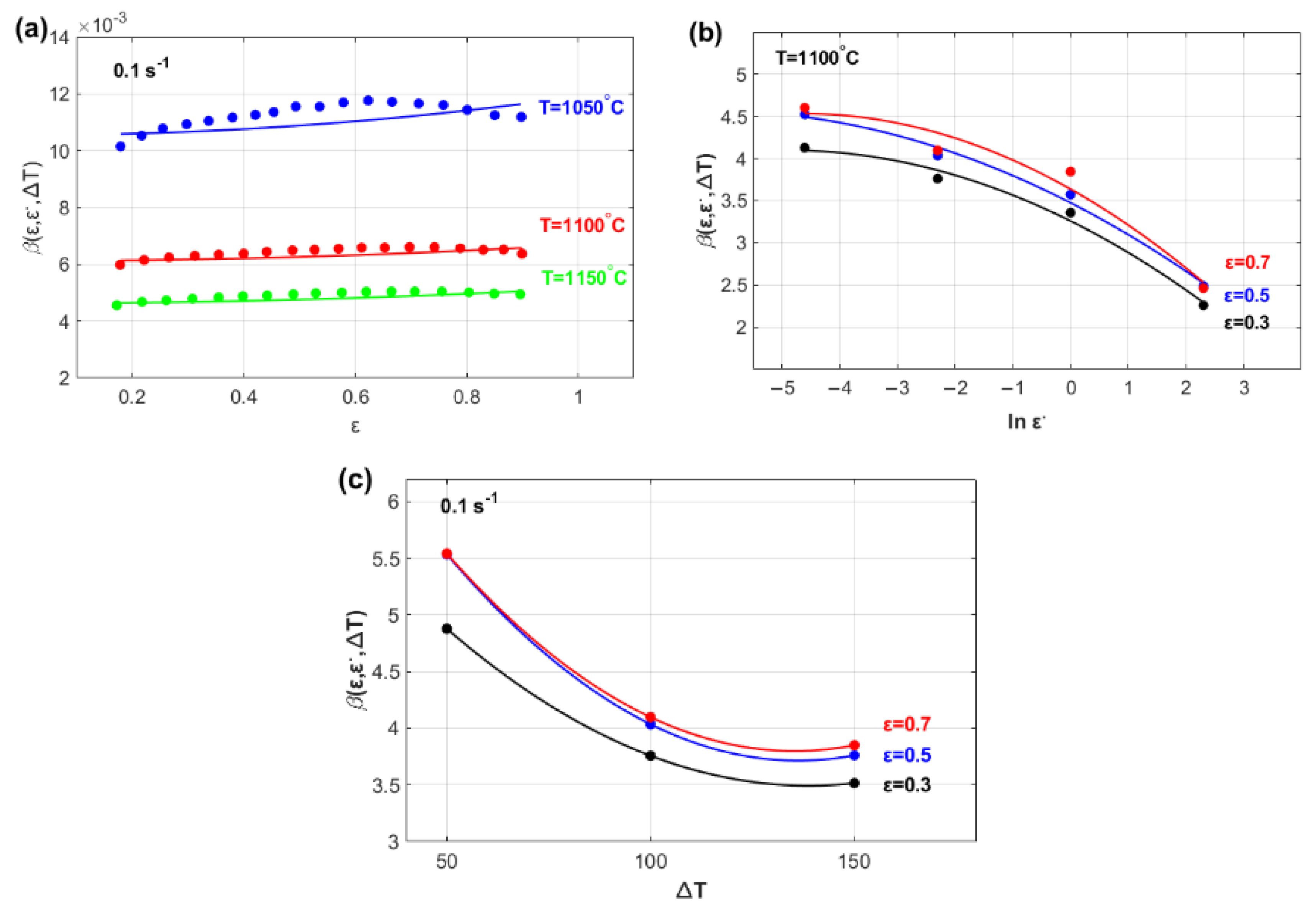
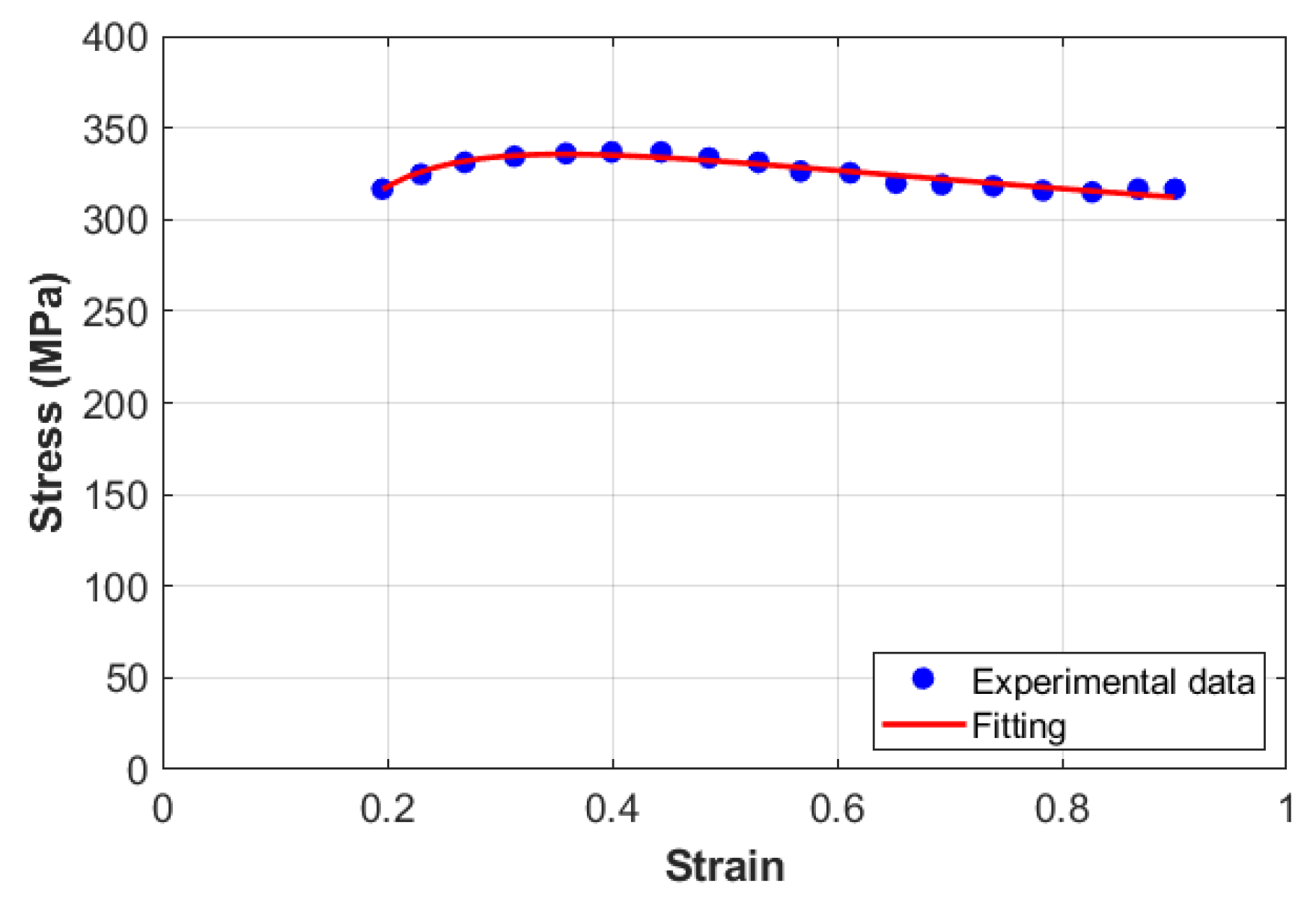


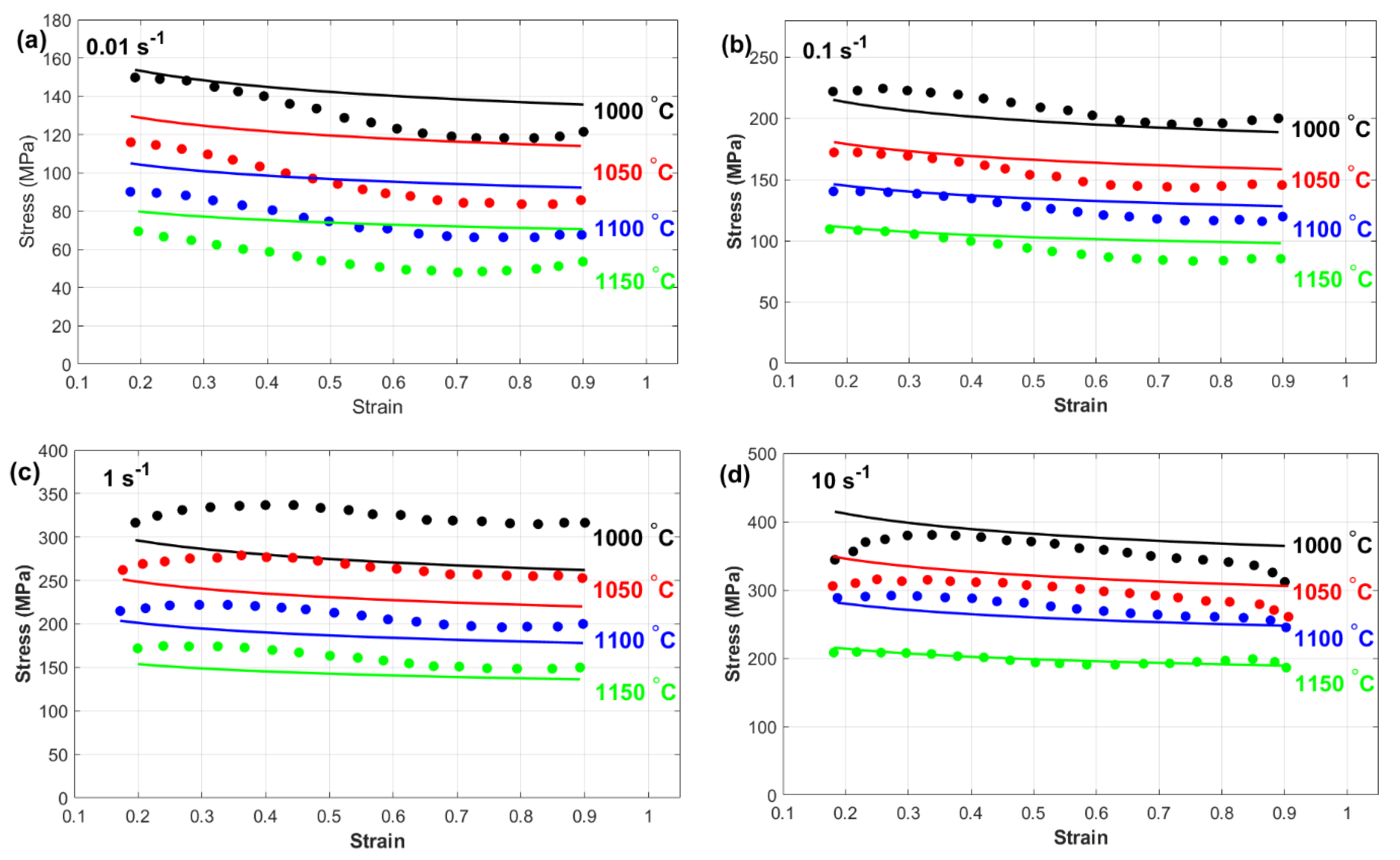
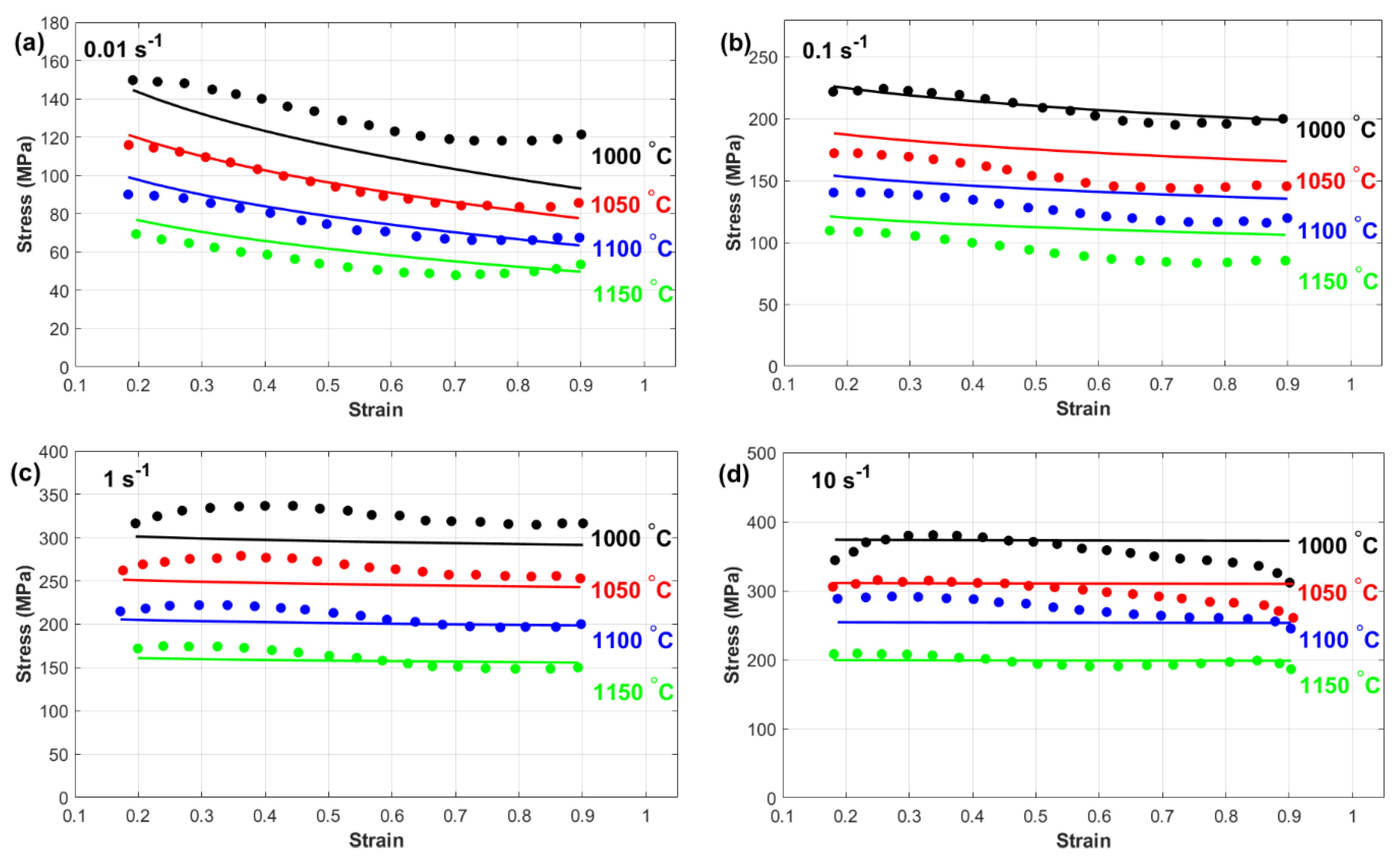

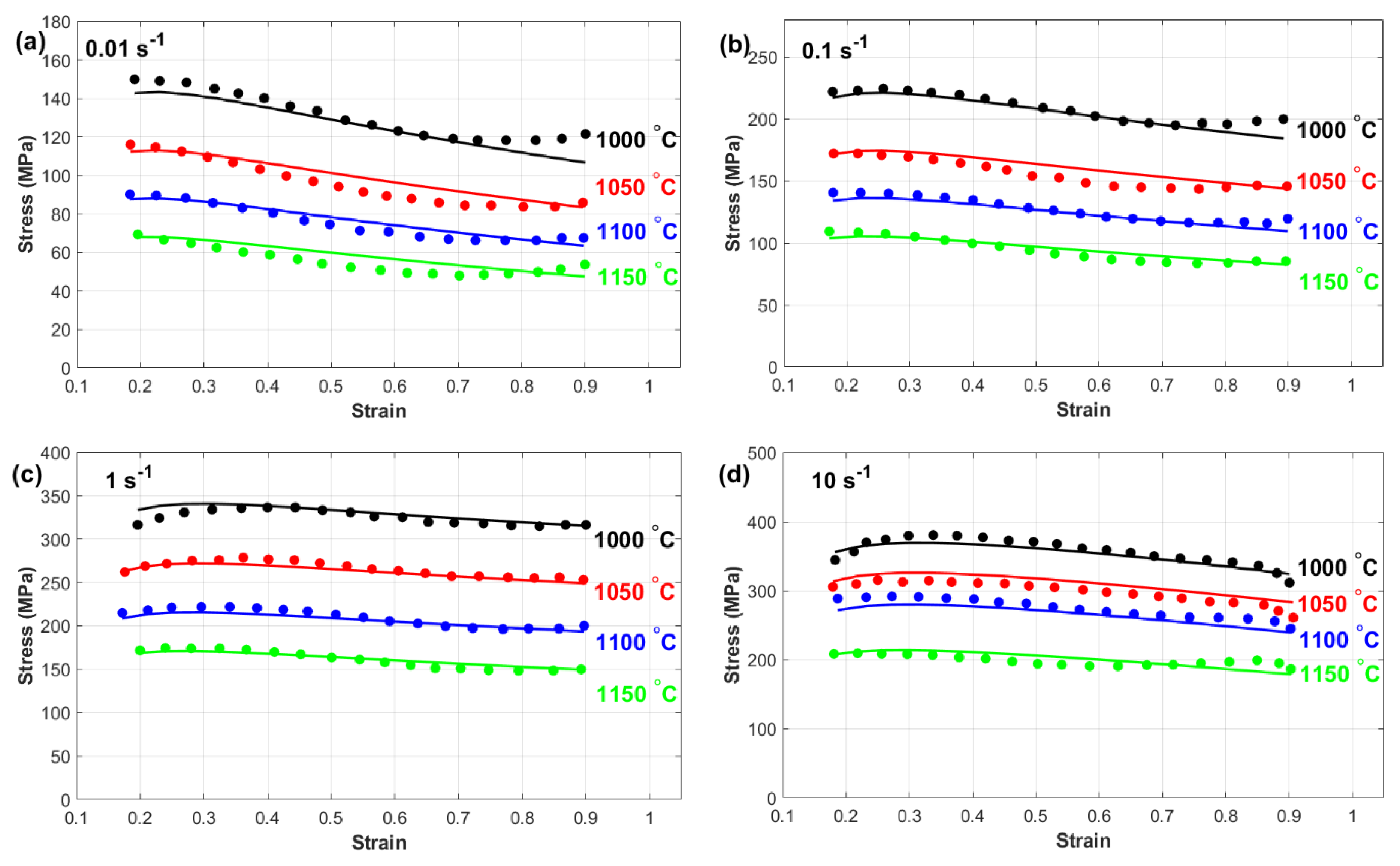

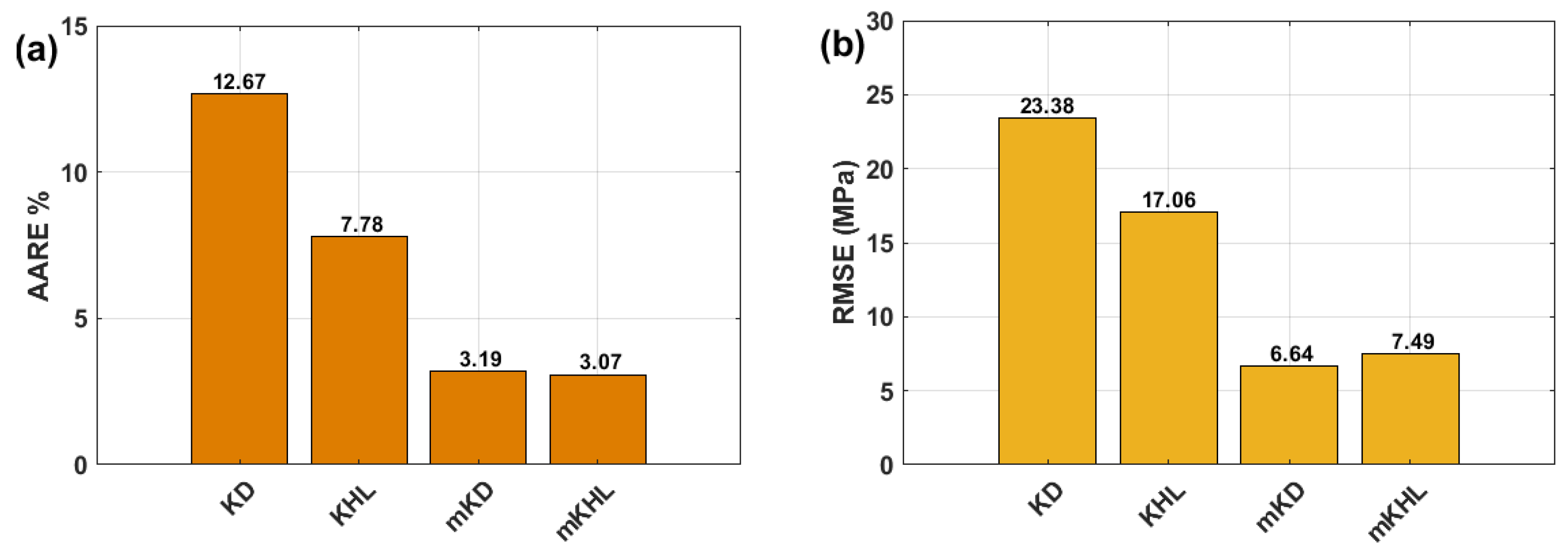
| σ0 [MPa] | n | m | β | |
|---|---|---|---|---|
| Superalloy 925 | 259.86 | −0.081 | 0.143 | 0.0032 |
| A [MPa] | B [MPa] | n1 | n0 | C | m | |
|---|---|---|---|---|---|---|
| Superalloy 925 | 316.50 | −25.64 | 2.899 | 0.322 | 0.075 | 0.933 |
| σ0 [MPa] | n0 | n1 | m0 | m1 | m2 | |
|---|---|---|---|---|---|---|
| Superalloy 925 | 311.61 | −0.137 | 0.018 | 0.171 | 0.072 | −0.015 |
| m3 | β0 | β1 | β2 | β3 | β4 | |
| −0.0009 | 0.0045 | 0.0003 | −0.0002 | −7.19 × 10−6 | 5.94 × 10−10 |
| A [MPa] | B [MPa] | n10 | n11 | n12 | |
|---|---|---|---|---|---|
| Superalloy 925 | 316.50 | 6.54 | 12.004 | 0.417 | 0.225 |
| n13 | C0 | C1 | C2 | C3 | |
| −0.244 | 0.349 | 0.140 | −0.134 | −0.035 | |
| m0 | m1 | m2 | m3 | m4 | |
| 1.023 | −0.198 | 0.063 | −0.141 | 0.032 |
Disclaimer/Publisher’s Note: The statements, opinions and data contained in all publications are solely those of the individual author(s) and contributor(s) and not of MDPI and/or the editor(s). MDPI and/or the editor(s) disclaim responsibility for any injury to people or property resulting from any ideas, methods, instructions or products referred to in the content. |
© 2025 by the authors. Licensee MDPI, Basel, Switzerland. This article is an open access article distributed under the terms and conditions of the Creative Commons Attribution (CC BY) license (https://creativecommons.org/licenses/by/4.0/).
Share and Cite
Abd El-Aty, A.; Xu, Y.; Alzahrani, B.; Ali, A.; Shokry, A. Advanced Constitutive Modeling of the Hot Deformation Behavior of Ni-Based Superalloys: Modified Kobayashi–Dodd and Khan–Huang–Liang Models with Experimental Validation. Materials 2025, 18, 2500. https://doi.org/10.3390/ma18112500
Abd El-Aty A, Xu Y, Alzahrani B, Ali A, Shokry A. Advanced Constitutive Modeling of the Hot Deformation Behavior of Ni-Based Superalloys: Modified Kobayashi–Dodd and Khan–Huang–Liang Models with Experimental Validation. Materials. 2025; 18(11):2500. https://doi.org/10.3390/ma18112500
Chicago/Turabian StyleAbd El-Aty, Ali, Yong Xu, Bandar Alzahrani, Alamry Ali, and Abdallah Shokry. 2025. "Advanced Constitutive Modeling of the Hot Deformation Behavior of Ni-Based Superalloys: Modified Kobayashi–Dodd and Khan–Huang–Liang Models with Experimental Validation" Materials 18, no. 11: 2500. https://doi.org/10.3390/ma18112500
APA StyleAbd El-Aty, A., Xu, Y., Alzahrani, B., Ali, A., & Shokry, A. (2025). Advanced Constitutive Modeling of the Hot Deformation Behavior of Ni-Based Superalloys: Modified Kobayashi–Dodd and Khan–Huang–Liang Models with Experimental Validation. Materials, 18(11), 2500. https://doi.org/10.3390/ma18112500










